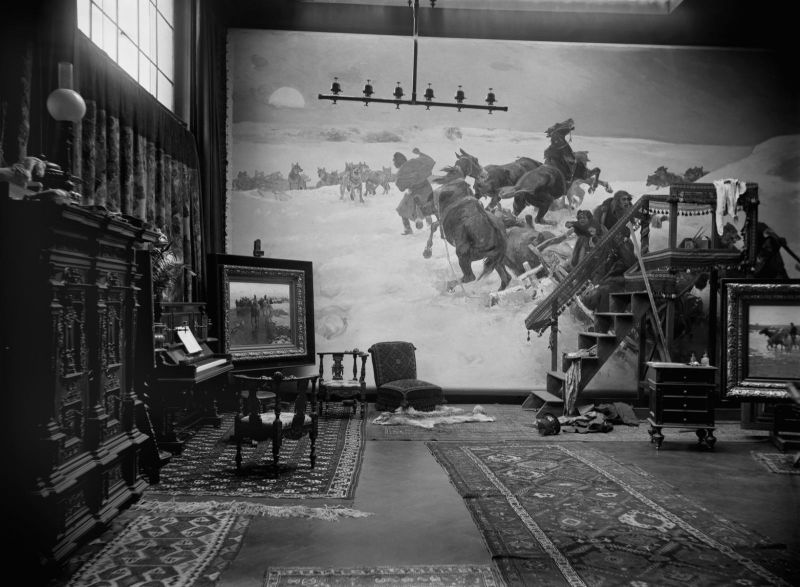Ateliers of Polish painters in Munich ca. 1890
Mediathek Sorted
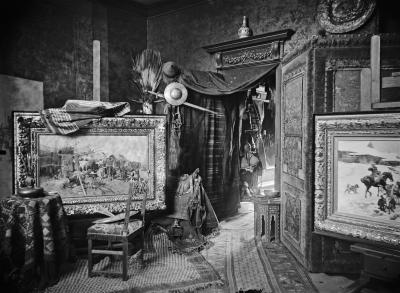
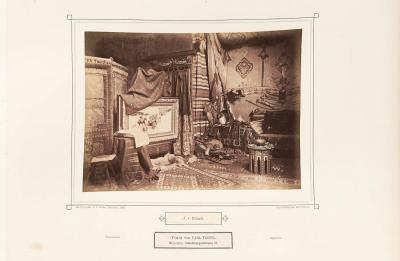

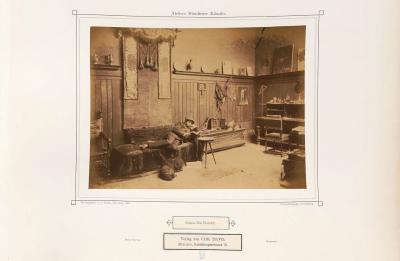






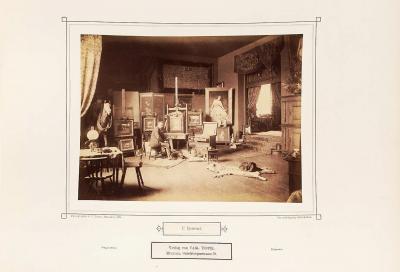




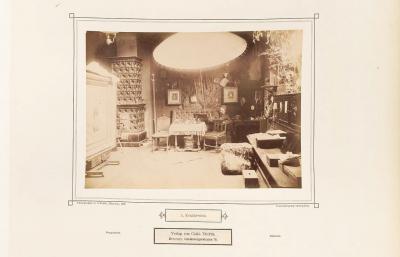


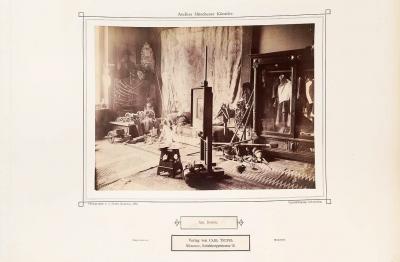



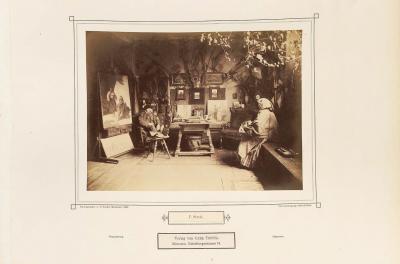

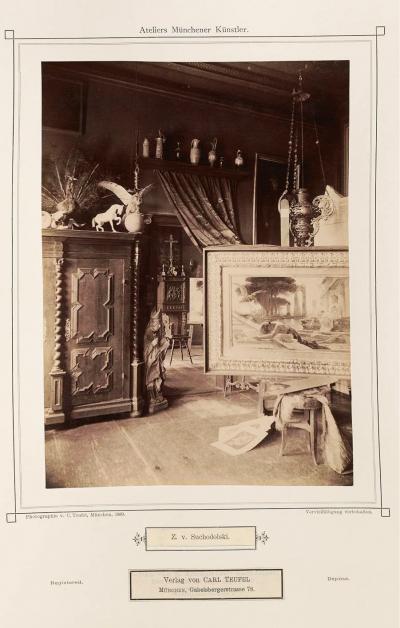

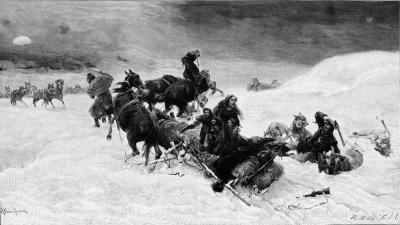


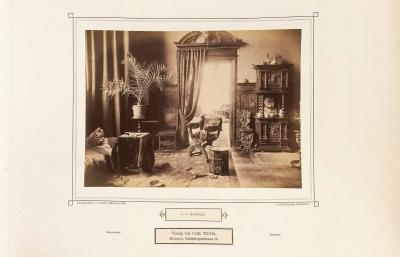
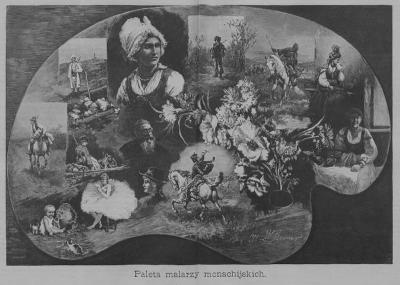


Around 1891, paintings by Brandt, Wierusz-Kowalski and Aleksander Gierymski could be seen in the Neue Pinakothek, which filled the members of the Polish artist colony with pride when they were hung in the permanent collection, particularly since Brandt signed his paintings with the suffix “z Warszawy” (in English from Warsaw) and with the Polish-speaking place name “Monachium” instead of “Munich”.[128] When Prince Regent Luitpold died in 1912, paintings by Brandt, Wierusz-Kowalski, Czachórski, Chełmiński, Stanisław Grocholski (1860-1932)[129] and Wywiórski were found in his art collection.[130] At the time that Teufel was creating the majority of his atelier photographs, that is to say 1889/90, many Polish artists had, of course, just left Munich or were already long gone. Take Apoloniusz Kędzierski (1861-1939)[131], for example, who returned to Warsaw in 1889 after four years of study, or Ludwik de Laveaux (1868-1894)[132], who moved to Paris in 1890. Others studied in the first few semesters at the Art Academy, such as Władysław Pochwalski (1860-1924)[133] or Józef Puacz (1863-1927)[134] or came very much later.
Judging from the Polish artists that Teufel selected for consideration, he must have got his list of names form the circle around Brandt and Wierusz-Kowalski. However, if all the really established Polish artists in Munich had been considered, the list could have been a lot longer: Szerner, a painter of accomplished equestrian scenes, who had studied in Munich from 1865 and worked for a long time in Brandt’s atelier as an assistant, stayed in Munich until the end of his days in 1915. His atelier was located on the third floor above that of Brandt at Schwanthalerstraße 19, whilst he lived in Goethestraße 29[135] not far from Wierusz-Kowalski. Olga Boznańska, a highly talented and proficient figure and portrait painter, who had studied in Munich under private teachers since 1886 and who took part in the exhibitions in the Glaspalast from 1888, opened her own atelier in the following year, which she successfully ran until she left for Paris in 1898.[136] Aleksander Gierymski, who had studied in Munich from 1868-72, was back in the city from 1888 to 1890 and painted, among other things, his famous Munich cityscapes by night. In 1890, the Neue Pinakothek acquired its painting of “Wittelsbacher Platz”, that had previously been awarded a medal in the Annual Exhibition in the Glaspalast.[137] His atelier was at Amalienstraße 49 in Maxvorstadt, but he lived in Adalbertstraße 27.[138] In 1890, Otolia Kraszewska (1859-1945)[139], a painter of figures and interiors who had trained at the Art Academy in St. Petersburg, came to Munich, lived at Sophienstraße 5 in Maxvorstadt, took part in exhibitions in the Glaspalast from 1892 and remained in the Bavarian capital to the end of her days.
Also established in Munich at this time, was the landscape painter Roman Kochanowski (1856-1945)[140], who had come to Munich in 1881 after studying in Krakow and Vienna and worked as an artist in Munich until the end of his life. In all, the Munich Art Association acquired ten paintings from him in 1890 and in the following years and they were then raffled off amongst the members as an annual prize. Kochanowski resided at Landwehrstraße 29.[141] From 1880 and 1881 respectively, Szymanowski and Grocholski studied in Munich and between 1891 and 1893 opened a private painting school together in a house in Munich-Pasing, where numerous Polish artists studied. Kurella, who visited the Munich Art Academy from 1861 to 1867, was friends with Brandt, the Gierymski brothers, Józef Chełmoński (1849-1914)[142] and Czachórski, and was one of the most active members of the Polish artist colony. He painted genre themes from village and small-town life in Poland as well as religious scenes, lived at Schwanthalerstraße 36[143] and worked as an artist in Munich until 1897. Wywiórski studied at the academy from 1883 to 1887, but had also taken private lessons in the ateliers of Brandt and Wierusz-Kowalski and followed the style of their motifs at the beginning. He travelled throughout Europe and in 1889 travelled with Wojciech Kossak to Egypt to prepare a panorama about the “Battle at the Pyramids”. In Munich, he lived at Theresienstraße 148.[144] In 1894, he went to Berlin to work in Kossak’s atelier, with Pułaski following him a year later.
[128] Ptaszyńska 2008, page XII
[129] Detailed biography in the Encyclopaedia Polonica, https://www.porta-polonica.de/de/lexikon/grocholski-stanislaw
[130] Ptaszyńska 2008, page XIII
[131] Detailed biography in the Encyclopaedia Polonica, https://www.porta-polonica.de/de/lexikon/kedzierski-apoloniusz
[132] Detailed biography in the Encyclopaedia Polonica, https://www.porta-polonica.de/de/lexikon/laveaux-ludwik-de
[133] Detailed biography in the Encyclopaedia Polonica, https://www.porta-polonica.de/de/lexikon/pochwalski-wladyslaw
[134] Detailed biography in the Encyclopaedia Polonica, https://www.porta-polonica.de/de/lexikon/puacz-jozef
[135] Munich address book 1890, Part I, page 361
[136] Detailed biography in the Encyclopaedia Polonica, https://www.porta-polonica.de/de/lexikon/boznanska-olga; online exhibition “Olga Boznańska” in this portal, https://www.porta-polonica.de/de/atlas-der-erinnerungsorte/olga-boznanska
[137] see the online exhibition “Aleksander Gierymski” in this portal, Figure 11, https://www.porta-polonica.de/de/atlas-der-erinnerungsorte/aleksander-gierymski
[138] Munich address book 1890, Part I, page 102 Detailed biography in the Encyclopaedia Polonica, https://www.porta-polonica.de/de/lexikon/gierymski-aleksander
[139] Detailed biography in the Encyclopaedia Polonica, https://www.porta-polonica.de/de/lexikon/kraszewska-otolia
[140] Detailed biography in the Encyclopaedia Polonica, https://www.porta-polonica.de/de/lexikon/kochanowski-roman
[141] Munich address book 1890, Part I, page 179
[142] Detailed biography in the Encyclopaedia Polonica, https://www.porta-polonica.de/de/lexikon/chelmonski-jozef
[143] Munich address book 1890, Part I, page 193
[144] Munich address book 1893, Part I, page 131(Gorstkin Wywiorski)





















































































